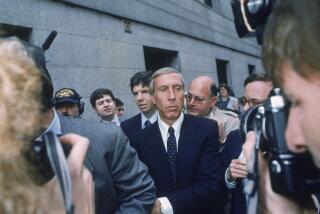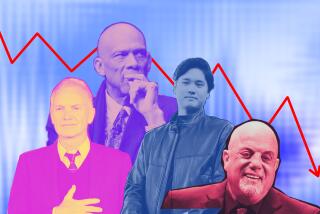When the Cops Left Wall Street : When Greed Was Good DEN OF THIEVES<i> By James B. Stewart (Simon & Schuster: $25; 493 pp.) </i> : EAGLE ON THE STREET<i> By Steve Coll and David Vise (Charles Scribner’s Sons: $24.95; 384 pp.) </i>
- Share via
Alan Dershowitz, the famous Harvard law professor, attacked “Den of Thieves” and its author James B. Stewart last week for bum raps on Dershowitz’ client Michael Milken and for a pattern of religious references that smelled like anti-Semitism.
Dershowitz, known recently for obtaining a reversal of the wife-murder conviction of Klaus von Bulow, is properly fierce in defense of his client--who is serving a ten-year term in federal prison at Pleasanton, Calif. Readers may take a different view of the market impresario who loaded up the now-failed Columbia Savings and Executive Life Insurance Co. with his junk bond merchandise.
And while they may conclude that “Den of Thieves” inappropriately details the Jewish backgrounds of the felonious main characters, they also will find that it’s a book about non-sectarian crookedness and a rollicking account of the insider trading and market manipulation scandals of the 1980s.
Stewart, an editor of the Wall St. Journal who won a Pulitzer Prize writing about the scandals, focuses his story mainly on the activities of Dennis Levine, Martin Siegel, Ivan Boesky and Milken.
Like malefactors in the 1920s, they profited from trading ahead of the public on inside information and from manipulating stock prices through secretly pooled share purchases.
But they did not act alone. Siegel’s inside trading at Kidder Peabody was in cooperation with Robert Freeman, a partner at Goldman Sachs who regularly betrayed the trust of clients such as Unocal for his own gain and that of his firm.
Nor were the manipulations kept secret from Wall Street’s leadership. Stewart relates a scene in which Siegel, having invested Kidder Peabody’s funds in the stock of Continental Group, is asked by his boss Ralph De Nunzio, chairman of Kidder, how he can be so confident that a price-boosting sale of the company is imminent.
Siegel replies: “This information is coming from Bob Freeman”--who worked for Continental’s investment banker. And De Nunzio’s response to this disclosure of insider trading is to tell Siegel, “Protect yourself.” He now knew where the profits were coming from; he didn’t want to know anything more.
In “Eagle on the Street,” Pulitzer-Prize-winning Washington Post reporters Steve Coll and David Vise suggest that this shadowy climate of deal-making and information trading became pervasive because an enfeebled Securities and Exchange Commission failed to enforce the law.
They tell their story through the philosophy and career of John Shad, SEC chairman from 1981 to 1987. It was Shad’s belief, and that of the Reagan Administration, that because market forces were self-regulating, anti-trust and securities laws were counterproductive.
The view contrasted sharply with decades of SEC tradition and the SEC staff’s “sense of being policemen enforcing morality on the byways of American capitalism.”
Nonetheless, Shad’s SEC took the cop off the beat in the hope that markets would flourish.
Instead crime and abuse flourished, write the authors, as speculators and freebooters threatened companies. They recount in detail the spectacle of employees of Phillips Petroleum in Bartlesville, Okla., praying for their jobs while T. Boone Pickens and Boesky and Milken and Carl Icahn conspire through bids and threats to extort money.
And through it all the highbinders lecture insufferably: Boesky telling UC Berkeley students that “I think greed is healthy”; Icahn claiming that his extortion is therapy for the failures of corporate management.
As in the ‘80s, readers will find themselves asking why the circus could go on so long. In a sense both books, the one on the robbers and the other on the cops, give too narrow an answer; they attempt to encompass the ocean by describing the sailors.
A big part of the answer lies in the background, in what preceded the raucous ‘80s. From 1963 to 1980 common stock investments earned a low average return of 2.49%, according to figures compiled by Ibbotson Associates of Chicago and Harvard professor Carliss Baldwin. The pension funds of America, responsible for investing the retirement savings of millions of employees, needed a better return.
Milken offered high-interest bonds of small or troubled companies, and sold them by arguing that you could as easily get burned with investment grade bonds of big companies. He had no trouble finding customers among bank trust departments and pension funds whose bond investments had been savaged in the inflationary 1970s.
The fact is, the 1980s opened with an investment crisis; even Social Security was going broke. That was why Shad and the Reagan Administration tried to take the reins off the markets.
In some cases, these books argue, the cure was worse than the disease. Both recount vividly how the actions of government lawyers and prosecutors, working through a tortuous process of plea bargaining, brought the villains to justice and the abuses to an end.
There are no Pollyannaish endings. Except for Milken, all of the identified villains got off with light sentences and today enjoy some of their ill-gotten gains. Also, the beat goes on. As these books went to press, news broke of manipulation in the government bond markets.
But that does not negate the value of these books as guides for the perplexed about the high jinks of the ‘80s, a decade that in its excesses and recessionary aftermath already recalls the roaring ‘20s.
Nor does it diminish the importance of honest markets.
In that respect, Stewart’s title, “Den of Thieves,” is unfortunate--and has aroused controversy. It is taken from a passage in Matthew’s gospel--ostentatiously printed in the book’s frontispiece--wherein the money-changers are chased from the temple.
The stock and bond markets are not temples, and never have been. They are markets that have seen sharp dealers before and will again.
The real point of these books, and of our uneasiness about the turmoil of the ‘80s, is better stated in Stewart’s prologue: “Violations of securities laws are not victimless crimes,” he writes. “When prices are manipulated and blocks of stock secretly accumulated, our confidence in the underlying fairness of the market is shattered. We are all victims.”
We are victimized because the markets have become so much more important in our lives. They are the arena in which pension funds invest the retirement money of 100 million American employees--not to mention the retirement funds of Japanese and British and other workers, too.
Therefore, intelligent regulation is imperative and probity and trust are necessary. May the ‘90s see more of those qualities than did the ‘80s.
More to Read
Sign up for our Book Club newsletter
Get the latest news, events and more from the Los Angeles Times Book Club, and help us get L.A. reading and talking.
You may occasionally receive promotional content from the Los Angeles Times.










